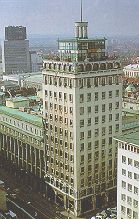 mein wahrzeichen ljubljanas: der neboticnik
mein wahrzeichen ljubljanas: der neboticnikdamals (mitte der 90er), auf der durchreise nach triest, haben wir hier zwischenstation gemacht und uns ein wenig als touristen umgeschaut. das etwas verwahrloste cafe im dachgeschoss des neboticnik war damals noch geöffnet und wir sassen dort bei kaffee und zigaretten und liessen den blick über die stadt schweifen. einen stock darüber gab es eine art nachtbar, die allerdings schon damals geschlossen war.
einige jahre später hat mir eine angehende slowenische diplomatin erzählt, dass man das cafe deshalb geschlossen habe, weil sich angeblich von oben so viele menschen zu tode gestürzt hätten. aber so, wie ich das cafe damals erlebt habe, ist es einfach am kapitalismus und an sich selbst zugrunde gegangen
ich habe nochmals auf der ![]() Seite der slowenischen Regierung nachgesehen:
Seite der slowenischen Regierung nachgesehen:
Ljubljana's Neboticnik Is 70 Years Old (February, 2003).
The first Slovenian Neboticnik (Skyscraper, pronounced [nehboti:chni:k]), which is one of the symbols of Ljubljana, and which, besides the Ljubljana Castle, offers the most beautiful panoramic view of the city, was constructed by the Slovenian architect Vladimir Subic (1894 - 1946). Its inauguration was on 21 February 1933, and with its 70.35 metres of height it was for some time the tallest residential building in Europe.
The investor of Neboticnik was Pension Institute, which also selected Subic as a skyscraper's designer. In accordance with its statute, the Pension Institute was obliged to invest part of its capital into real estate, therefore soon after its establishment it began with a large-scale constructing action the result of which were numerous buildings in Ljubljana and Slovenia.
When they began building Neboticnik in July 1930, the news about its construction quite upset Slovenian public, especially the residents of Ljubljana. Some of them immediately labelled it a freak that would spoil the baroque silhouette of the city. Subic accepted modernism and functional architecture and he designed Neboticnik on the basis of the classical tripartite division of tall buildings, pioneered by the American architect Louis Sullivan and others. In accordance with this set-up, Neboticnik has a base connected with the street and pedestrians, a homogeneous shaft and a crown.
Neboticnik, which was constructed in a remarkably short time, with the then revolutionary application of reinforced concrete, is a 13-floor office and residential building with shops on the ground floor and on the first floor. From the second to the fifth floors, there are offices, while apartments are located from the sixth to the ninth floors. On the last three floors, there are a café, a bar, and an observation terrace. The top of the building on the thirteenth floor is concluded by a gloriette with a rising flagpole.
The entrance to the building leads to a magnificent vestibule walled with Karst marble from where it is possible to continue one's way up with one of the three elevators representing the main vertical communication of the building: two of the elevators are fast and take one to the café on the tenth and the eleventh floors, while the third one, which is slightly slower, was made for the residents of the building. In addition, a monumental spiral staircase rises up from the ground floor and leads all the way to the tenth floor.
Technically innovative elements are used not only for the communication system - the elevators, but also in the mechanical system. Heating is central with automatic oil burners, and from the sixth floor upward water is supplied with automatic pumps. All the café premises have pressure-ventilation and hot water supplied centrally from the basement. The multi-use program and functional scheme is decorated with neo-classical and art-deco elements and crowned with pilasters at the top of building. In planning and constructing Neboticnik, the strictest Japanese anti-seismic construction criteria were taken into account. Thus, Neboticnik rests on 16 supporting pillars that are set 18 metres into solid ground. This construction makes it one of the most earthquake-safe buildings in Ljubljana.
A four-metre colossal sculpture of a woman, which adorns the facade of Neboticnik overlooking the main street, is a work of Slovenian sculptor Lojze Dolinar (1893 - 1970). Its main purpose was to alleviate connection between a much lower neighbouring bank and a new skyscraper.


